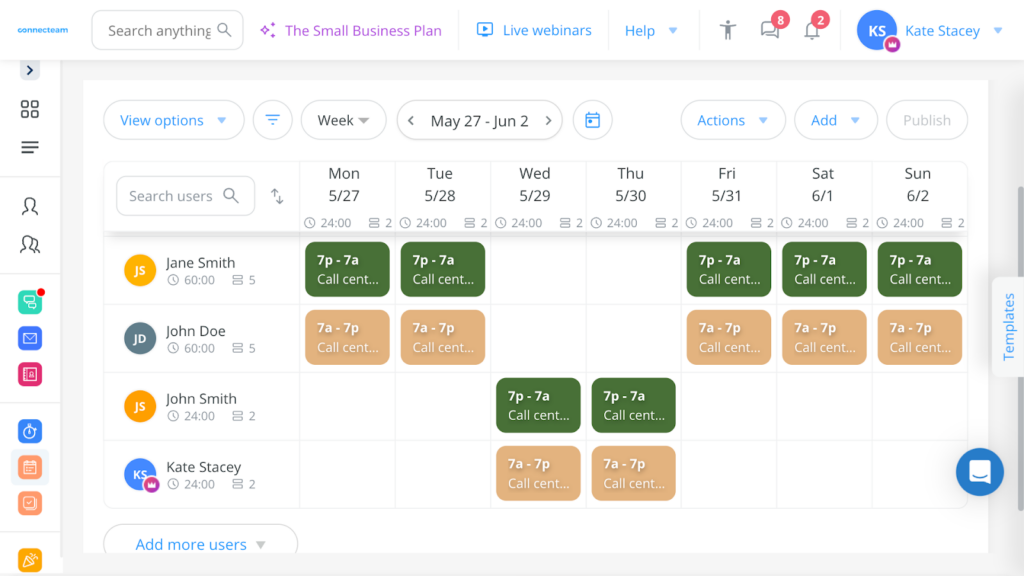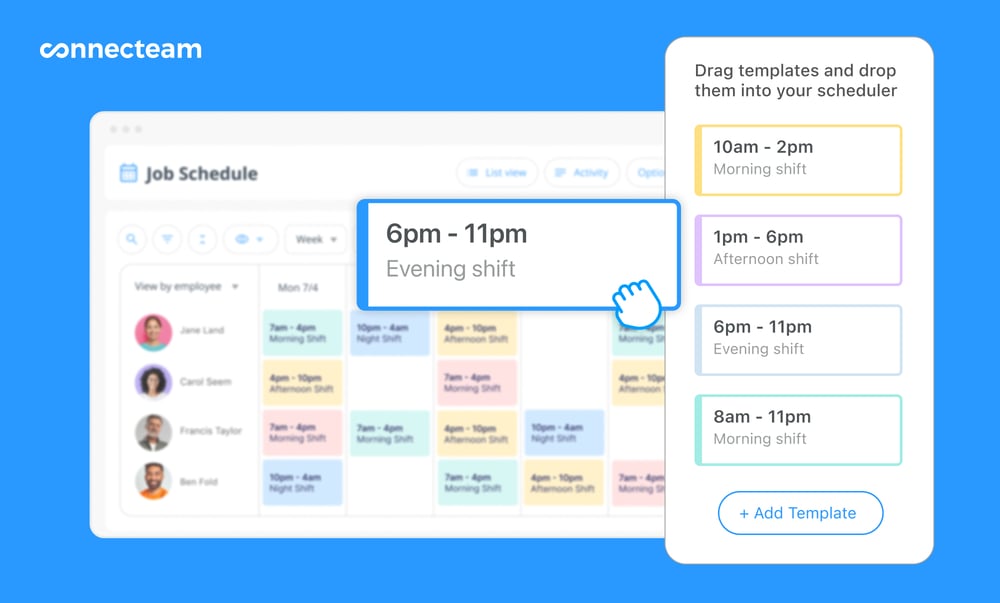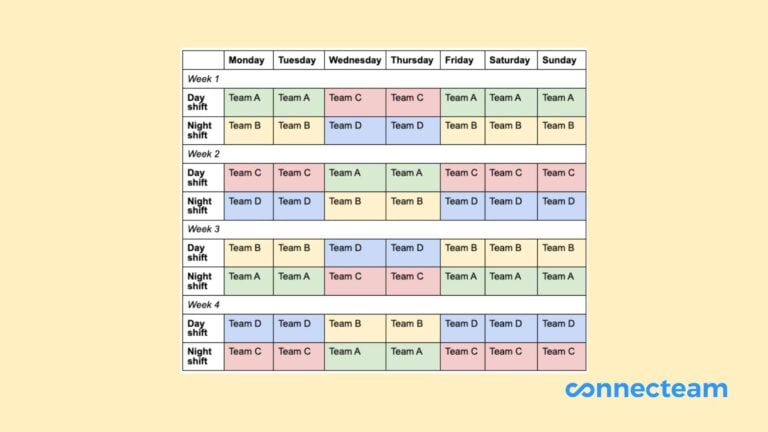A 2-2-3 schedule is often used by businesses that operate 24/7. Read on for our comprehensive guide including what a 2-2-3 schedule is, when to use one, and how to successfully use them to schedule your workforce.
Effective scheduling is key to success when you run a business that operates 24/7. You need to find a schedule that covers every working hour and ensures employees don’t burn out, fall sick, or make mistakes due to exhaustion.
The 2-2-3—or Panama—schedule may be the solution you’re looking for. In this article, we look at how this schedule works, its pros and cons, and some tips for implementing it successfully.
Key Takeaways
- The 2-2-3 work schedule involves 4 teams rotating through 12-hour shifts across a 28-day shift cycle. The basic shift pattern is 2 workdays, then 2 days off, then 3 workdays.
- The 2-2-3 schedule is ideal for businesses that run 24/7. It ensures employees have a large number of days off each year.
- However, it requires employees to work both day and night shifts, which can affect your employees’ well-being if not managed well. You must also ensure your 2-2-3 schedule complies with relevant labor laws.
- Providing your employees with training on how to adjust to night shifts, communicating schedules clearly with them, and using a digital scheduling system are best practices for implementing this schedule.
What Is a 2-2-3 Work Schedule?
A 2-2-3 schedule—or Panama schedule—is designed for businesses with 24/7 operations with employees working 12-hour shifts across a 28-day cycle. The basic shift pattern is 2 days on, 2 days off, and 3 days on, with teams alternating between day and night shifts every 2 weeks.
Did You Know?
There isn’t a consensus on the origins of the term “Panama schedule.” However, it’s generally recognized as having military origins and may be a reference to the US Army’s operations in the Panama Canal.
How Does a 2-2-3 Schedule Work?
In a 2-2-3 schedule, employees are grouped into 4 teams and scheduled to work various 12-hour shifts over a 28-day or 4-week cycle. Teams usually work day or night shifts for 2 weeks, then they’ll switch.
In the 1st week, Team A:
- Works 2 day shifts.
- Has 2 days off.
- Works 3 more day shifts.
In the 2nd week, Team A:
- Has 2 days off.
- Works 2 day shifts.
- Has 3 days off.
The schedule repeats for Team A in weeks 3 and 4. However, this time, they work the night shifts.
The other 3 teams are organized around this to ensure a team is always on duty. Team B works the night shifts according to the above schedule, and Teams C and D work the 2nd week first to cover Team A and B’s days off.
Here’s an overview of the 28 days in a 2-2-3 schedule:
| Monday | Tuesday | Wednesday | Thursday | Friday | Saturday | Sunday | |
| Week 1 | |||||||
| Day shift | Team A | Team A | Team C | Team C | Team A | Team A | Team A |
| Night shift | Team B | Team B | Team D | Team D | Team B | Team B | Team B |
| Week 2 | |||||||
| Day shift | Team C | Team C | Team A | Team A | Team C | Team C | Team C |
| Night shift | Team D | Team D | Team B | Team B | Team D | Team D | Team D |
| Week 3 | |||||||
| Day shift | Team B | Team B | Team D | Team D | Team B | Team B | Team B |
| Night shift | Team A | Team A | Team C | Team C | Team A | Team A | Team A |
| Week 4 | |||||||
| Day shift | Team D | Team D | Team B | Team B | Team D | Team D | Team D |
| Night shift | Team C | Team C | Team A | Team A | Team C | Team C | Team C |
A 2-2-3 schedule results in your employees working 14 12-hour shifts every 28 days. Over a year, an employee works around 180 days.
This schedule structure is typical in industries and workplaces that require 24/7 staffing, including:
- Cleaning.
- Police stations.
- Healthcare.
- Manufacturing.
- Call centers.
- Transportation.
- Gas stations.

Example 2-2-3 schedule
Here’s an example of 4 weeks of a 2-2-3 schedule.




The Benefits of a 2-2-3 Schedule
There are several advantages to using a Panama shift schedule.
Allows your business to run 24/7
With staff covering every hour of the day, you can always serve your customers, deliver your service, or manufacture your product. This is great if your industry demands 24/7 coverage or you’re looking to grow your profits with non-stop operations.
Offers employees adequate breaks
A 2-2-3 schedule is a good way to cover 24/7 operations without your employees burning out. They get a good amount of time off throughout the schedule cycle, including regular breaks between shifts. Employees never work more than 3 consecutive days and get a 3-day weekend every 2 weeks.
This gives them time off to rest, recover, and spend time with family and friends—so they can return to work refreshed and recharged.
Relies on longer shifts
You may want your employees to work the longer shifts required by a 2-2-3 schedule. This may be for business reasons, such as the nature of the work. Employees might also request this because they can get more done during longer shifts or prefer working longer hours but fewer days.
Requires less staff
As your employees work longer shifts, you require fewer people to cover your business’s hours of operation—freeing up resources for other business needs.
Better work-life balance for employees
A 2-2-3 schedule gives employees the most days off in a year out of all the 24/7 schedules. Plus, employees regularly have 2 to 3 consecutive days off in a row to focus on things outside of work, like family, health, and interests. More time off can support some of your employees’ work-life balance, improving their well-being.
Offers employees scheduling predictability
A 2-2-3 schedule gives employees a degree of predictability with their schedules—they know what shifts they have and when. So, they can plan medical appointments and other commitments. This is more convenient for your workers and reduces time off requests.
The Challenges of Using a 2-2-3 Schedule
Here are some considerations you should make before deciding to use a Panama schedule.
Impact of shift work on employees’ health
Shift work—especially switching between day and night shifts—impacts workers’ health. It can disrupt employees’ sleep—leading to fatigue and affecting the quality of their work and mental health.
Studies have also shown that night shifts can increase some long-term health risks, including for certain cancers, heart attacks, and diabetes. Night shift workers also tend to eat less healthy food, impacting their overall health.
12 hour shifts may be too long for some employees
Twelve hours may be too long for some employees, especially those who are used to 8-hour working days or have disabilities or medical conditions. A 2-2-3 schedule may put these employees at increased risk of burnout.
Rotating shifts may not suit some employees
Not all employees can work a different schedule every week—for example, those with childcare arrangements may need to choose fixed childcare days and won’t be able to change these days each week.
A 2-2-3 schedule also requires employees to work some evenings and weekends. This may not suit some employees.
This Might Interest You
Want to know what employees really think of the 2-2-3 schedule? Look on Reddit, where various workers (like this one) share their feelings about and experiences with this and other 24/7 schedules. Reddit posts can give you insights into how people with different roles, life responsibilities, and more view and approach this schedule.
Complex schedule arrangements
You and your employees might need time to understand and adjust to a 2-2-3 work schedule. You also need to plan what to do when a worker calls in sick or requests leave. When asking another employee to cover their shift, you must be mindful of night shift workers and how an additional shift may impact them.
Labor Laws Relevant to 2-2-3 Schedules
In addition to the above challenges, ensuring your 2-3-3 schedule complies with any relevant federal and state laws is essential. Here are just some of these laws.
Overtime
Under a 2-2-3 schedule, employees will sometimes work 60-hour weeks. It’s essential to be aware of any overtime regulations that apply to these employees so that they can be paid correctly.
At the federal level, employers covered by the Fair Labor Standards Act (FLSA) must pay non-exempt employees at 1.5 times their regular pay rate for any hours worked over 40 in one week. It’s important to understand which employees overtime applies to—some employees are exempt from federal overtime requirements.
There may also be more generous overtime laws at the state level that apply to your employees. For example, several states count any hours over 8 hours in a day as overtime, and overtime rates vary.
Meal and rest breaks
2-2-3 schedules require employees to work 12 hours at a time. You need to ensure you offer employees mandatory breaks—at a minimum—during this time and pay for them if needed.
There’s no federal law that requires employers to provide employees with breaks. But if you do, the FLSA requires you to pay employees for short breaks (i.e., generally those shorter than 30 minutes).
Many states also have their own meal and rest break laws. For example, New York employers must provide non-factory evening shift workers who work more than 6 hours with 45-minute breaks.
Leave laws
If you use a Panama schedule, you must consider any leave your employees are entitled to.
For example, under the federal Family and Medical Leave Act, certain employees are entitled to up to 12 weeks of unpaid, job-protected leave. Under state laws, employees may also have mandatory holiday, sick, or maternity leave.
You need to adapt your schedule—and ensure you have enough staff—to accommodate these leave entitlements.
Specific 2-2-3 schedule laws
Some states specifically regulate the use of these types of schedules.
For example, California regulates alternative schedules—schedules that allow employees to work longer shifts on fewer workdays. California employers can’t introduce an alternative schedule unless 2/3 of their employees approve it. Employers must conduct an employee poll and send the results to the Department of Industrial Relations within 30 days to verify them.
Pro Tip
If you’re considering implementing a 2-2-3 schedule, it’s important to speak with a labor lawyer to understand the relevant federal and state laws you must comply with. You can also check out our state labor law guides as a starting point.
4 Tips for Implementing a 2-2-3 Schedule
Prepare your workplace
Create the ideal conditions in your workplace to support workers on a 2-2-3 schedule. For example, ensure you provide them with enough breaks and a comfortable break space, including facilities for workers to take short naps.
This helps them adjust to their schedule—especially when switching between day and night shifts—and return from breaks more energized and productive.
Also, consider workspace lighting. Adequately lit areas help nighttime workers adjust to their schedules and be more alert.
Communicate clearly with your employees
When first implementing a 2-2-3 work schedule, help your employees understand the shift patterns and how best to manage them. A good way to do this is to provide training—either online or in person—on topics like sleep hygiene and adjusting to night shifts.
This Might Interest You
We put together a guide on how to start and implement a successful employee training program.
Advice like taking short walks during breaks and limiting caffeine intake can help employees adjust to their new schedule.
Employees should always have access to their schedules and be made aware of any changes or updates immediately.
Take employee feedback onboard
Don’t forget that communication goes both ways. Your employees may provide feedback or express their scheduling preferences, such as their ideal shift start times.
You can collect feedback informally or formally—for example, by sending out an employee pulse survey.
Listen to your workers’ feedback and try to incorporate it into your scheduling.
Use a digital scheduling app
Manually creating and maintaining a 2-2-3 schedule can be time-consuming and lead to scheduling errors. Using scheduling software lets you automate schedule creation, saving you time.
You can also keep schedules in a central location so your employees have easy, all-hours access.
Many apps also allow you to set rules or have built-in compliance features to help you keep track of overtime and avoid unlawful scheduling practices.
Did You Know?
Connecteam’s AI shift scheduler creates schedules in just seconds, based on your workers’ availability, preferences, and qualifications. You can also set shift reminders for employees and notify them of schedule changes in real-time. Other employee management features like surveys, chat, and training are ideal when introducing 2-2-3 scheduling to your workforce.
Alternatives to the 2-2-3 Schedule
If the 2-2-3 schedule doesn’t sound right for your business, there are several other 24/7 schedules to consider.
| Number of teams | Length of shifts | Length of shift cycle | Rotation cycle | Pros and cons | |
| Panama Plus schedule | 5 teams | 8 and 12 hours | 280 days | 2 day/night shifts, 2 days off, 3 day/night shifts, 2 days off, 2 days/night shifts, then 3 days off for 8 weeks (12-hour shifts). Then work 8-hour day shifts for 2 consecutive weeks. This is repeated 4 times. Often used in industries that operate 24/7 but also need to give staff time to train or do paperwork—e.g., healthcare. | + Employees get 2 weeks of 8-hour shifts every 2 months – Long cycles and sustained 12-hour shifts can impact employees’ well-being |
| Pitman schedule | 4 teams | 12 hours | 14 days | 2 day/night shifts, 3 days off, then 2 day/night shifts. Next week they have 2 days off, 3 days on, then 2 days off. | + Employees get 3 consecutive days off every 2 weeks – Employees may work up to 60 hours in some weeks |
| DDNNOO schedule | 3 teams | 12 hours | 6 days | 2 day shifts, 2 night shifts, 2 days off | + Good for smaller businesses – Regularly switching between day and night shifts can be challenging for some employees |
| DuPont schedule | 4 teams | 12 hours | 4 weeks | 4 different shift schedules, 1 for each week of the cycle: Schedule 1: 4 night shifts, then 3 days offSchedule 2: 3 day shifts, then 1 day off, then 3 night shiftsSchedule 3: 3 days off, then 4 day shiftsSchedule 4: 7 days off Each team starts with a different schedule and cycles through all 4 by the end of 4 weeks | + Predictable and flexible for employees – Requires employees to work 72 hours in some weeks |
Optimize Your 2-2-3 schedule With Connecteam
2-2-3 schedules are a scheduling option for businesses that operate 24/7. Compared to other schedules, they offer employees scheduling predictability and generous time off.
However, they require employees to work night shifts and weekends. So, it’s important to be mindful of your workers’ well-being—and any applicable laws—if you decide to implement one.

Connecteam is the ideal tool for creating, sharing, and updating 2-2-3 schedules. Making a schedule takes just a few minutes, and it’s stored in a central location so your employees can always access it. The app immediately notifies employees of any schedule changes—so you can rest assured that employees never miss a shift. Plus, you can enable employees to swap shifts.
You can also share a read-only link to the schedule with clients or stakeholders, ensuring they stay informed about work patterns and crew availability.
Ready to find out how Connecteam can help you with schedules, time tracking, communication, and employee training? Try it for free today!
FAQs
How many hours a week is a 2/2/3 schedule?
In a 2/2/3 or Panama schedule, employees work 60 hours one week, then 24 hours the following week.
What is the best rotating shift schedule?
The best rotating shift schedule depends on your business and employees’ needs. A 2-2-3 schedule gives employees the most days off in a year. Meanwhile, with a fixed Pitman schedule, employees don’t rotate between day and night shifts. One schedule might suit your employees more than the other.





